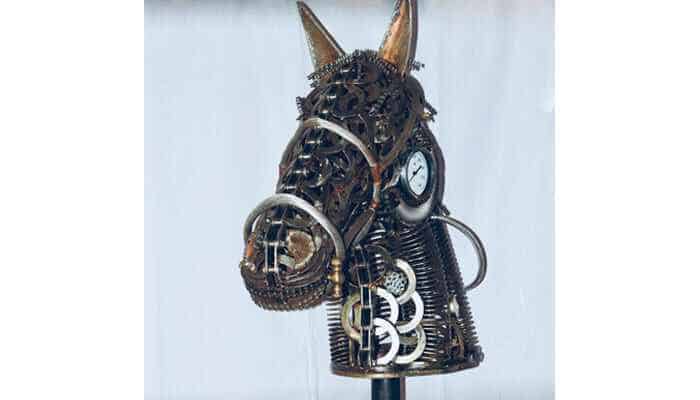The sculptor Robert ‘Mojo’ Mojeski occupies an oddly wonderful place in the Hamptons art scene. Though he’s spent much of his life on eastern Long Island, he operates at a remove from the local art world. While his best-known sculpture, Tipping Point — a bright yellow orb fastened to the top of a massive ladder-like structure in a Sagaponack field — is a veritable landmark, the man who made it remains a relative unknown. At a time when artists’ personalities eclipse their output, Mojo’s anonymity speaks of an earlier time when the art was more important than its maker. Beholden to no one, he creates for the sheer joy of it. And though he doesn’t make art for a market, much less to please a collector, the sight of his whimsical assemblages of rebar and scrap metal in fields throughout the East End please a lot of people.
His monumental sculptures come to him in fully-formed images. But instead of putting those images down on paper — by his own account, he draws “like a child” — he goes straight to his studio and begins to tinker. “Until a piece is finished, I have trouble sleeping and focusing,” he says. An intuitive, self-taught artist, he fabricates his pieces entirely by eye and adjusts scale and proportions as he sees fit. That’s pretty unusual given the intricacy of his work and the mechanical challenges they represent.

Mojo has had a lot of practice resolving technical challenges by eye, having worked with metal since he was a kid. When he was thirteen years old, his dad gave him an arc welder for Christmas. “From that day on,” he says, “every baby carriage in my Southampton neighborhood was glued together by little old me.” And later work as a lampmaker taught him how to visualize three dimensional objects and hold them in his imagination, a skill that has served his art well. “A piece of sculpture isn’t like a painting or an object that’ll be hung on a wall,” he notes. “My pieces are meant to be seen from all sides and directions.”
Are they ever! Mojo’s sculptures bend and bob and sway in response to their environment. They’re hardly ever still. It’s no coincidence that he earned his living as a commercial fisherman before he turned to art, trading one uncertain occupation for another. “I feel as though the fluid quality in my work was something I absorbed from the water,” he muses. Even his stationary pieces have that same liquid-y quality. Take the giant dead-eyed shark he recently finished. Fabricated from high-grade stainless steel, there is nevertheless something ethereal about it. Mojo says he polished and polished the sea creature until he could see his own reflection in it from head to tail. Viewed from a distance, it seems to be moving through water. “I love movement,” he says, “and I’m not satisfied with a sculpture unless it also suggests forward motion.”










!['The Maples' is a prestigious generational compound of two extraordinary estates: 18 Maple and 22 Maple. This rare offering, designed by luxury architect Lissoni partners New York and developed by visionaries Alessandro Zampedri-CFF Real Estate and JK Living, redefines opulence with the highest quality of craftsmanship and captivating views of the Atlantic Ocean. Represented by @nycsilversurfer and @challahbackgirl of @douglaselliman. [link in bio]](https://hamptonsrealestateshowcase.com/wp-content/uploads/sb-instagram-feed-images/438891010_1083749139481747_7890082604579275354_nfull.jpg)
![Featuring 360-degree water views on Mecox Bay, the Atlantic Ocean and Channel Pond, 1025 Flying Point offers the ultimate beach cottage that is flooded with natural light. With panoramic views, proximity to the ocean, and a private walkway to Mecox bay for kayaking or paddle boarding, this truly is a special retreat. Represented by @ritcheyhowe.realestate and @hollyhodderhamptons of @sothebysrealty. [link in bio]](https://hamptonsrealestateshowcase.com/wp-content/uploads/sb-instagram-feed-images/438994305_737511778456166_4602476013493875279_nfull.jpg)
![Attention advertisers! 📣 Secure your spot in the highly anticipated Memorial Day edition #HRES. Reach thousands of potential clients and showcase your brand in one of the most sought-after publications in the Hamptons, NYC, Palm Beach, and beyond. Contact us now to reserve your ad space! [link in bio]](https://hamptonsrealestateshowcase.com/wp-content/uploads/sb-instagram-feed-images/438549843_275102939023235_6718257301437562124_nfull.jpg)
![You eat with your eyes, and on the East End, it’s important that what you eat looks just as good as how it tastes. At @rosies.amagansett, the restaurant itself is plenty photo-worthy with blue ceramic tiling and yellow and white striped fabric wallpaper. But for a dish that will light up your photos, head directly to the salmon tartare! [link in bio]](https://hamptonsrealestateshowcase.com/wp-content/uploads/sb-instagram-feed-images/437094269_7296727147115953_1594410326824303644_nfull.jpg)

![We were honored to be the media sponsor for @blackmountaincapital's open house event with @jameskpeyton and @jfrangeskos at 11 Dering Lane in East Hampton! Other sponsors included @landrover, Feline Vodka, @rustikcakestudio, @la_parmigiana, @lahaciendamexicangrill11968, @homesteadwindows, Stone Castle, @talobuilders, and @thecorcorangroup.
A big thank you Carrie Brudner of Black Mountain Capital for putting together this fabulous event! [link in bio]](https://hamptonsrealestateshowcase.com/wp-content/uploads/sb-instagram-feed-images/437081213_762912965932136_6847332836522786568_nfull.jpg)

![Blooms Galore at the Long Island Tulip Festival! 🌷✨ Mark your calendars for April 15th as the vibrant tulips at @waterdrinkerlongisland burst into full bloom! Enjoy a day filled with colorful splendor, food trucks, live music, and more. [link in bio]](https://hamptonsrealestateshowcase.com/wp-content/uploads/sb-instagram-feed-images/437083429_974242677583725_6855805712693638343_nfull.jpg)
